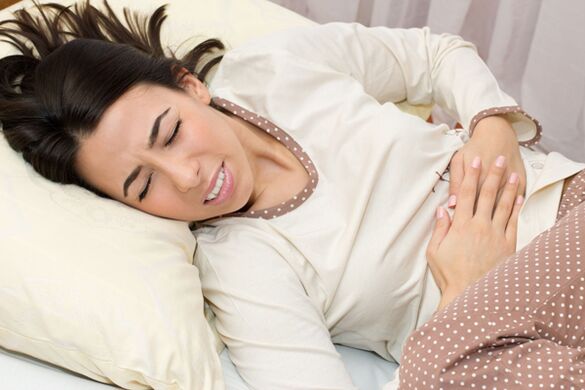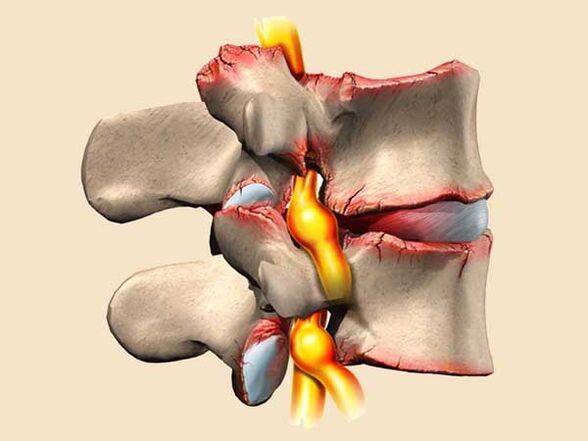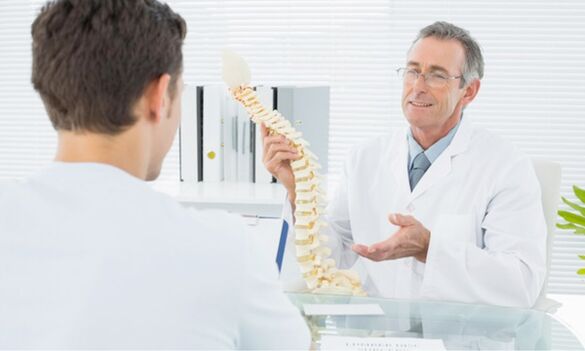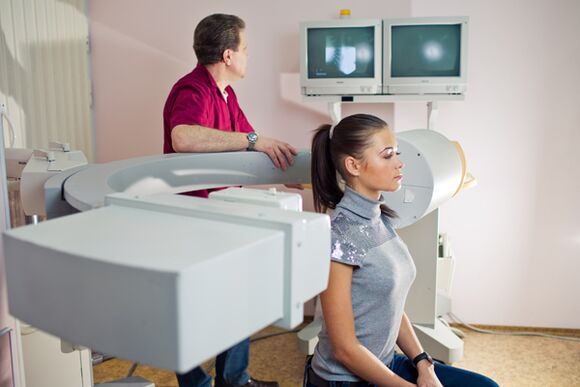Osteochondrosis of the thoracic spine (TOP) is a dystrophic (destructive) degenerative change in the functioning and condition of the intervertebral fibrocartilaginous formations (discs).
This disease, despite its high frequency, is characterized by the difficulty of detection in the initial stage of development, because its symptoms are similar to gastrointestinal diseases (peptic ulcer, gastritis, gastrologic syndrome in colitis), angina pectoris and sometimes myocardial infarction.

Osteochondrosis of the thoracic spine is very difficult to diagnose.
Less often, this disease is "disguised" as renal colic with cholecystitis or appendicitis. That's why you need to know the symptoms of osteochondrosis of the thoracic spine in order to correctly diagnose it and start treatment on time.
How does osteochondrosis GOP develop?
In the human spine (more precisely, in the column) there are 33 to 35 vertebrae, which are connected by elastic discs, which consist of connective tissue and a nucleus.
So, with the development of the disease (that's about 12 vertebrae), the connective tissues around the intervertebral discs are deformed, which is why their elasticity decreases.
As a result, the discs lose their inherent strength and elasticity, leading to one of two scenarios over time:
- rupture of discs, due to which intervertebral hernias appear;
- spinal deformity + damage to certain vertebrae in the spinal column.

The second scenario is a consequence of the growth of bony growths along the edges of the spine, their deformation and thinning.
There are 4 degrees of deformation in osteochondrosis of the thoracic spine:
- Reduced elasticity and height of discs, protrusions may appear.
- Osteochondrosis of the 2nd degree of the thoracic spine is characterized by a further decrease in the elasticity and height of the discs, instability of the GOP. As a result, the appearance of neurological symptoms or hernias.
- Intervertebral hernia formation.
- Discs lose their cushioning properties. Vertebrae, approaching, almost completely lose mobility.
Causes of disease
The main reason for the development of this disease is aging, because according to statistics, the symptoms of osteochondrosis of the thoracic region are found, as a rule, in people over 35 years old. What contributes to the deterioration of metabolism, the "accumulation" of injuries and the general wear and tear of the spine.
In other words, the older the patient, the greater the probability of detecting signs of thoracic osteochondrosis in him.
However, to be fair, it should be noted that recently, more and more patients aged 19-30 are turning to neurologists with chest pains, which are increasingly being diagnosed as symptoms of thoracic osteochondrosis. Doctors explain such dynamics with poor physical fitness, poor nutrition, curvature of the spine and flat feet. These offenses are typical for people who live in an urban environment with an "office" job.

Common causes of the development of thoracic osteochondrosis:
- spinal injury;
- genetic predisposition;
- immobility;
- overweight and smoking (metabolic disorders);
- prolonged exposure of the spine to improper positions;
- excessive loads;
- improper, poor nutrition (lack of liquid and trace elements);
- spine overload due to various diseases or wearing uncomfortable shoes;
- stressful situations, nervous tension;
- breach of posture;
- diseases that lead to metabolic disorders.
Symptoms and signs of chondrosis of the chest
As already mentioned, sensations in thoracic osteochondrosis (symptoms) very often resemble other diseases, because they are less pronounced compared to other types of this disease.
That is why it is very important not to engage in self-diagnosis, but to consult a qualified doctor in case of long-term, periodic or "without cause" pain in the thoracic spine.

Symptoms of osteochondrosis GOP:
- pain between the shoulder blades when bending or raising the arm(s) up;
- pain between ribs when walking;
- with thoracic osteochondrosis, it is difficult to breathe with increased pain during deep inhalation or exhalation;
- sensation as if the back and chest were tight with a hoop.
Chest pain in thoracic osteochondrosis occurs:
- after or during a long stay in one position;
- slopes;
- physical activity;
- turns;
- at night.
Additional (special) symptoms of thoracic osteochondrosis, which can be disguised as other diseases, especially in women:
- ringing and noise in the ears;
- frequent headaches;
- hoarseness and hoarseness;
- drop in blood pressure;
- numbness of limbs;
- a burning sensation in the chest, similar to pain in the heart during a heart attack, angina pectoris or pathology of the mammary glands;
- in old age, frequent loss of consciousness;
- attacks of shortness of breath;
- constant tension of neck muscles;
- frequent hiccups.

It is worth noting that in women the symptoms of osteochondrosis of GOP are more pronounced, because their vertebrae are smaller and the connective tissue is thinner.
It is important to clarify that, contrary to popular belief, in osteochondrosis of the thoracic spine, the body temperature does not rise precisely because of this disease. However, it can increase due to inflammatory processes caused by osteochondrosis of GOP.
Characteristics of pain
In osteochondrosis, pain in the sternum is manifested as:
- Dorsalgia - mild, nagging, tiring pain in the area of damaged discs, which gradually increases and lasts up to 2-3 weeks;
- Dorsago is a strong, sharp, acute pain during an attack of thoracic osteochondrosis, which is also called "chest pain".
Diagnosis
Since osteochondrosis of the thoracic spine is rarer than other types of this disease, and its symptoms are typical of other diseases, establishing the correct diagnosis sometimes takes a long time (trial and error). And only after excluding the most obvious options, doctors turn their attention to the symptoms of osteochondrosis.
Therefore, experts recommend contacting medical institutions specializing in problems with the musculoskeletal system in case of manifestation of characteristic pain sensations.

The diagnostic process itself takes place in 2 phases:
- Establishing the primary diagnosis: examination and examination of the patient. As a rule, this is done by a neurologist. Using a special technique, he examines the spine in different positions, states of rest and movement, paying attention to the structure of the body, posture and the line of sharp processes. After determining the signs of osteochondrosis of GOP, a more detailed examination (finger) of the damaged area is carried out in order to determine the location and degree of the disease.
- Further, after the initial diagnosis, the patient is sent for a basic and more detailed examination of the thoracic spine: X-ray, CT and MRI.
How is osteochondrosis GOP treated?
Treatment is almost always carried out with conservative methods aimed at preventing the development of the disease, removing pain, and restoring the functions of the spine.
If that doesn't work, then surgery should be done.
Conservative treatment includes:
- physiotherapy;
- special diet;
- therapeutic blockade;
- massage;
- drug therapy;
- manual technique;
- spinal traction;
- reflexology;
- physiotherapy exercises (LFK).
Prevention
The methods for preventing the occurrence of osteochondrosis GOP are very simple:
- prevent hypothermia of the spine;
- avoid excessive loads;
- frequent change of posture during "office", sitting work and breaks every hour of 5-10 minutes;
- morning training.



































